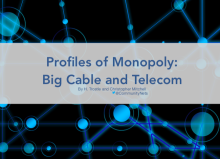These Minnesotans Are Fed Up With Frontier
People in Wyoming, Minnesota, gathered together on September 12th to bend the ear of officials from the state’s Public Utilities Commission (PUC). Ann Treacy from the Blandin Foundation attended the meeting and recorded most of the conversation from the 100 or so frustrated and fed-up folks. The meeting was one of five organized by the PUC after a record number of complaints by incumbent telephone and Internet access provider Frontier.
A Shared Reality
It’s safe to say that “frustration” was the star of the night, as everyone who spoke mentioned how it had consumed their experience with Internet access from Frontier. People who spoke at the meeting included those who worked from home, business owners, parents with families whose kids needed Internet access for homework, and retired folks who just wanted to enjoy a quiet evening streaming a movie.
Most of the people who spoke at the meeting said that they needed to run mobile hotspots or had given up on Frontier’s DSL service and now rely solely on hot spots to avoid the frustration of dealing with terrible service. Several people at the meeting don’t have the option of mobile hotspots because there’s no cell coverage where they live.
In addition to horribly unreliable connectivity, where the only consistency is dropped service, people expressed anger about overpaying for Internet access that was down far too often — even for weeks at a time. When they were able to get online, many people who spoke at the meeting reports horrifically slow speeds and feel they are being “ripped off” because they never reach the “up to” speed that they pay for each month. Once woman has documented her line’s performance and the fastest download speed she has reached is .96 Megabits per second (Mbps); the slowest is .05 Mbps. This same person has had limited success in cajoling Frontier to temporarily lower her bill since 2012.


